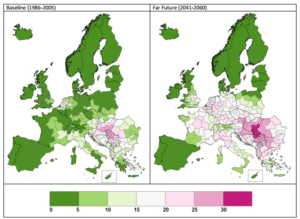 Percentage of population with allergies to ragweed pollen at baseline and in the future. Credit: University of East Anglia
Percentage of population with allergies to ragweed pollen at baseline and in the future. Credit: University of East Anglia Currently, ragweed allergy affects 33 million people in Europe. It’s a number that scientists’ projections indicate will grow to 77 million between 2041 and 2060.
Related allergy symptoms are likely to be more severe. Plus, they are projected to last over a longer period in peak autumn periods when the weed’s pollen proliferates. The researchers said that controlling the ragweed plant in response to climate change may be an important adaptation strategy.
“Pollen allergy is a major public health problem globally, but it has not been known what sort of an impact climate change will have,” said Dr. Iain Lake. He led the study, which involved creating maps of projected ragweed pollen counts, then combining them with population data and allergy levels to make predictions.
“Management of this invasive plant could reduce the amount of people affected to about 52 million,” he said.” However, “a scenario which sees very rapid plant invasion would increase the amount of people affected to around 107 million,” Lake added.
Climate Change Pushes Ragweed North
The researchers expect ragweed to move increasingly northward. They investigated the potential impacts of climate change on ragweed plant distribution, plant productivity, pollen production and dispersal. Then their paper considers the public health impact on allergies in Europe.
More people will develop ragweed-related hay fever in countries with an existing ragweed problem. However, the paper projects the greatest proportional increases will occur in countries such as France, Germany and Poland. Allergies related to ragweed in those countries are currently uncommon.
By 2041-2060, allergic sensitization to ragweed will be widespread across Europe. The exceptions would be Scandinavia, the Baltic States, most of Spain, Portugal and Ireland.
The pollen of highly invasive ragweed is at its height in late summer. Each plant is capable of producing about a billion grains of wind-borne pollen per season.
In their study, the scientists generated monthly maps of estimated ragweed pollen counts over a pollen season. They then estimate changes in the severity of ragweed allergy symptoms and their duration.
Climate to Affect Pollen’s Range
The scientists considered two different regional climate-pollen models, two greenhouse gas emissions scenarios and three different plant invasion scenarios.
Climate change will affect the range of the ragweed plant, the timing and length of the pollen season, the scientists say. As well, it will affect the dispersion of pollen, while elevated carbon dioxide emissions could increase plant productivity and pollen.
Projections suggest that ragweed pollen will remain airborne during mid-September to mid-October across most of Europe, likely due to delayed frosts.
Pollen is a major risk factor for allergic diseases such as allergic asthma and rhino-conjunctivitis, which can cause nasal congestion, runny nose, sneezing and itching of the nose or eyes.
In 2014, the total cost of allergic diseases in the European Union was estimated to cost between $61 to $168 million.





